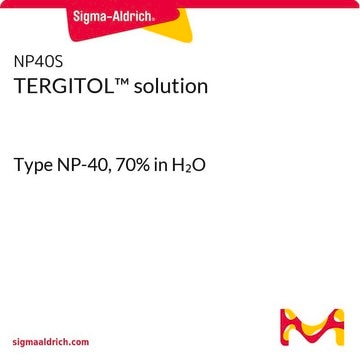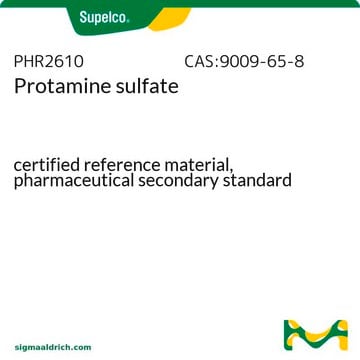P4530
Protamine-Agarose
saline suspension
Autenticatiper visualizzare i prezzi riservati alla tua organizzazione & contrattuali
About This Item
Numero MDL:
Codice UNSPSC:
41106500
Prodotti consigliati
Stato
saline suspension
Matrice
Cross-linked 4% beaded agarose
Attivazione matrice
cyanogen bromide
Gruppi immobilizzati alla matrice
amino
Braccio spaziatore
1 atom
Capacità
~50 μg/mL binding capacity (DNA)
Temperatura di conservazione
2-8°C
Applicazioni
Protamine-agarose is used in protein chromatography, affinity chromatography and specialty resins. Protamine-agarose has been used to determine that Pichia pastoris (methylotrophic yeast) provides a convenient heterologous system for the production of recombinant subunits of human type 2A protein phosphatase (PP2A). Protamine-agarose has also been used to purify and characterize a novel protamine kinase in HL60 cells as well as to study myocardial infarction.
Stato fisico
Suspension in 0.5 M NaCl containing 0.02% thimerosal
Esclusione di responsabilità
For U.S. Customers: Contains mercury; Do not place in trash - dispose according to local, state, or federal laws.


Codice della classe di stoccaggio
12 - Non Combustible Liquids
Classe di pericolosità dell'acqua (WGK)
WGK 3
Punto d’infiammabilità (°F)
Not applicable
Punto d’infiammabilità (°C)
Not applicable
Scegli una delle versioni più recenti:
Possiedi già questo prodotto?
I documenti relativi ai prodotti acquistati recentemente sono disponibili nell’Archivio dei documenti.
I M Helander et al.
European journal of biochemistry, 163(1), 51-55 (1987-02-16)
The ability of agarose-linked protamine to bind Salmonella typhimurium lipopolysaccharides was investigated. Radioactively labelled lipopolysaccharides were isolated both from a smooth strain (SH6749, labelled with [14C]galactose) and from a rough strain (SH5014, lipopolysaccharide chemotype Rb2, labelled with [3H]acetate). From 50-micrograms
M Junco et al.
FEBS letters, 263(1), 169-171 (1990-04-09)
Protein kinase C (PKC) and its proteolysis-derived protein kinase independent of Ca2+ and phospholipids (PKM), were purified from rat brain. By using histone H1 and protamine as substrates, we assayed the effect of several inhibitors of PKC and PKM. The
S Shibata et al.
Journal of biochemistry, 112(4), 552-556 (1992-10-01)
Calphobindins (CPBs, placental annexins) are intracellular Ca(2+)- and phospholipid-dependent proteins like protein kinase C [EC 2.7.1.37]. We investigated the inhibitory effects of calphobindins on the protein kinase C activity in vitro. CPB I inhibited the protein kinase C activity for
V B Lokeshwar et al.
The Journal of biological chemistry, 264(32), 19318-19326 (1989-11-15)
Treatment of Swiss mouse 3T3 cells and human epidermoid carcinoma A431 cells with protamine at 37 degrees C increased the 125I-epidermal growth factor (EGF) binding activity at 4 degrees C. The effect of protamine on the increase of 125I-EGF binding
L Boscá et al.
The Biochemical journal, 290 ( Pt 3), 827-832 (1993-03-15)
The structural changes following the binding to protein kinase C (PKC) of activators that promote its translocation to lipid environments were studied by far-u.v. c.d. and intrinsic fluorescence measurements of the protein. In the absence of activators, PKC contained 40%
Il team dei nostri ricercatori vanta grande esperienza in tutte le aree della ricerca quali Life Science, scienza dei materiali, sintesi chimica, cromatografia, discipline analitiche, ecc..
Contatta l'Assistenza Tecnica.






